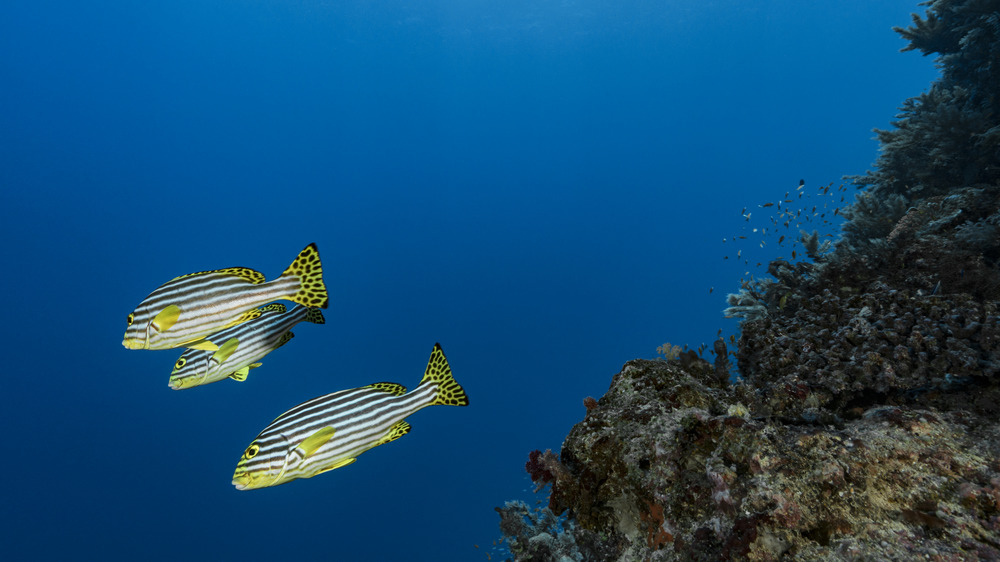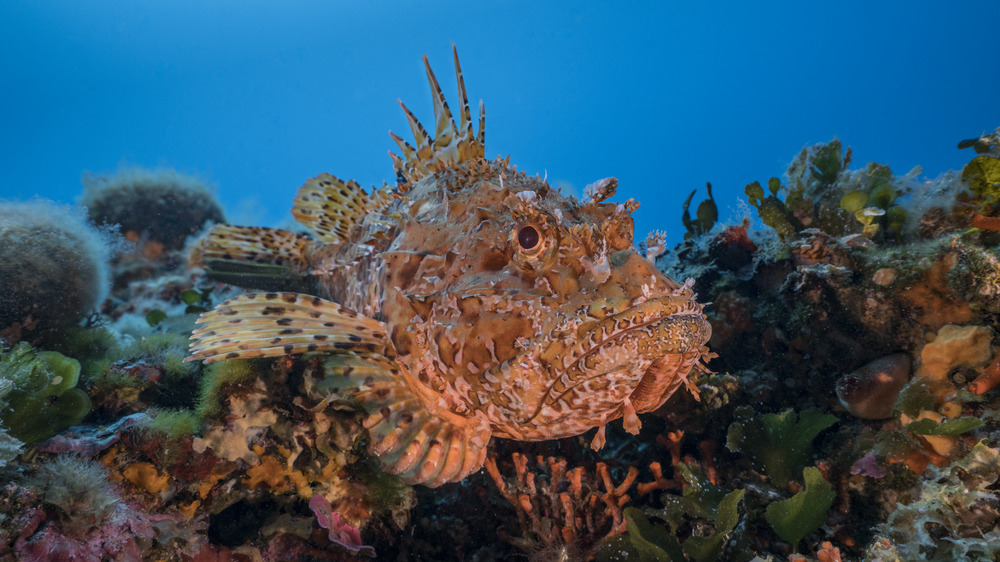The Truth About The Secret Language Of Fish
When you consider the many types of animals sharing planet Earth, what is it that makes humans unique? Is it our ability to walk on two legs? Certainly not — birds and apes can do this, too. How about our use of tools? Again, no; Live Science reports that many different creatures, from octopuses to elephants, have been observed using tools.
What about communication, then? Is that what distinguishes humans from other animals? It's true that no other species has a formal language structure as developed as the languages used by humans. But while speech might be a unique human trait, communication is definitely not. From bird calls to squeaks and barks, communication can be found across the animal kingdom, around the globe — including the ocean.
At first, you may be surprised to learn that fish are able to communicate with one another. If you've ever tried speaking underwater, you know how difficult that can be. But fish actually have a diverse array of communications methods that are available to them, including some that would be considered superpowers if they ever emerged in humans. How do our ocean-dwelling buddies interact with each other?
Many fish species communicate through sound
The primary way that humans communicate is via sound. This isn't unique to humans, of course; many birds and mammals also use sound to "talk" to each other. But landlubbers are not the only ones who make noises in order to communicate; many fish also communicate through sound.
Per Science ABC, researchers have identified three main types of communication noises among fish: croaks, purrs, and pops. Unlike humans, fish don't make these sounds with their mouths, but rather by vibrating their "swim bladders" — the gas-filled organs that allow these fish to control their buoyancy. Besides the swim bladder, fish can also make noises when harder body parts, like teeth and bones, strike each other. Due to their audio frequency, most fish sounds are inaudible to humans, but can be detected by underwater microphones. Per The New York Times, researchers in New Zealand have identified certain fish communicating in "choruses" that can last for up to three hours.
Fish make noises for a variety of reasons, such as breeding, fighting, or to identify the presence of predators or prey. For instance, the New Zealand researchers discovered that the bigeye fish (Pempheris adspersa) can make sounds which travel over 100 feet; they believe that these noises are likely used "to keep a group of fish together during nocturnal foraging." As further examples, oyster toadfish produce "courtship calls" to lure in potential mates, while damselfish make noises to scare predators away from their territories.
Fish also use motion to communicate, especially when in groups
Sound is certainly not the only way that fish are able to communicate with each other. If you've ever watched a nature documentary, or even Finding Nemo, you probably know that fish also communicate via motion. Motion is a form of communication that isn't too foreign to humans; while speech is our preferred means to deliver a message, motions and gestures are equally integral to the way we interact with one another. Although humans use motion in our one-on-one interactions, fish primarily communicate via motion when in collective groups, or "schools."
Per one article posted at PubMed, researchers determined that the motion of schools of fish combines elements of both order and flexibility. Apparently, fish are instinctively able to follow certain behavioral rules, like attraction, repulsion, and parallel-orientation. As a result, fish can take cues from their neighbors, and use those cues to swim in particular patterns, a process The New York Times describes as "highly regimented synchronized swimming." Much like with flocks of birds, this motion-based communication helps ensure the safety of individual fish as they travel together.
While sound and motion are the main ways that humans interact, some fish have access to an even wider array of communication methods.
Some fish can communicate in a variety of other ways
One prominent way that certain fish communicate is via color. Per Science ABC, some fish can brighten or darken their skin, or even change colors altogether. As Siren Fleet points out, this ability can be used to communicate both information and disinformation; while color changes are sometimes used to indicate preparedness for mating, they more frequently function as a means of camouflage. Octopuses and cuttlefish are particularly skilled at blending into their environments.
In a related way, certain fish use bioluminescence to communicate with one another, as well as with predators and prey. Bioluminescent effects — emitting light — are produced through chemical reactions in fish organs known as "photophores." Bioluminescence is particularly useful for deep-sea fish living in close to total darkness.
Additionally, some fish are known to communicate through smell. Science ABC reports that female zebrafish secrete pheromones in order to entice males into mating. Less pleasantly, some cichlids use urine to fend off rivals during displays of aggression.
Finally, certain fish are able to communicate via electrical impulses. The most famous example of this ability is found in the electric eel. Electric eels have specialized organs which can produce electrical charges of varying intensity; strong charges ward off predators and kill prey, while weaker ones are used to communicate with other electric eels nearby. Per the University of Virginia, numerous other fish also possess this shocking ability.



